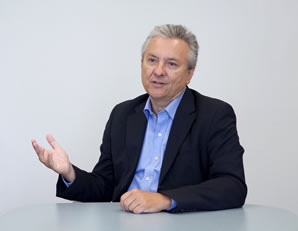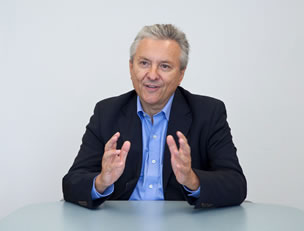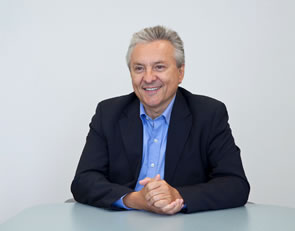Q & A With Berkeley Lab Deputy Director Horst Simon



Horst Simon, an internationally recognized expert in computer science and applied mathematics, was named Berkeley Lab's Deputy Director on September 13, 2010.
Simon joined the Lab in early 1996 as director of the newly formed National Energy Research Scientific Computing Center (NERSC), and was one of the key architects in establishing NERSC at its new location in Berkeley. Under his leadership NERSC enabled important discoveries in fields ranging from global climate modeling to astrophysics. Simon was also the founding director of Berkeley Lab's Computational Research Division, which conducts applied research and development in computer science, computational science, and applied mathematics.
In his tenure at the Lab, Simon has helped to establish Berkeley Lab as a world leader in providing supercomputing resources to support research. He also serves as an adjunct professor in the College of Engineering at UC Berkeley, where he has helped developing a designated graduate emphasis in computational science and engineering.
At the announcement of his appointment, Simon sat down with Public Affairs to share his vision about his new position as Deputy Director.
How do you see your role as Deputy Director of the Laboratory?
My first responsibility as deputy is to help the Lab Director develop and implement his strategic vision for the Lab. Paul Alivisatos has set the Lab’s research agenda, and he is the advocate for the most high profile projects, like the Next Generation Light Source and Carbon Cycle 2.0. I see the role of deputy as complementing the director, working closely with him to help him carry out his research priorities, but also to help nurture those projects that are of great importance, but perhaps not necessarily at the forefront of the Lab’s agenda. In the next decade we will also have exciting new scientific opportunities ahead in exascale computational science, matter and energy in the universe, and in the bio and life sciences. As a multi-program lab Berkeley Lab has a large and diverse portfolio of scientific programs, and I am looking forward to supporting the director in assuring the scientific success of all of our programs. And of course, part of my role is also to represent the lab’s scientific programs to DOE program managers and other stakeholders, and to build relationships with other laboratories, the university community and international collaborators.
You've had the benefit of observing a number of Director/Deputy relationships during your time here. What are some of the lessons you've learned from them, and how have they influenced your approach to the job?
I’ve worked with a lot of fine Deputy Directors, but one that had a particularly strong influence on me and my career was Pier Oddone. Pier was the deputy when I first arrived at the Lab, and I always thought of him as someone I could turn to when I needed help. In those days supercomputing was new to Berkeley Lab, and there were a lot of issues we faced, and Pier was very thoughtful and helpful to us as we integrated into the Lab.
In the same way, I’d like to serve as a trusted advisor to the scientific divisions and user facilities. I want to help them develop their programs and build their internal and external collaborations, to resolve problems and remove the obstacles that get in the way of them achieving their goals.
What are your plans for enabling cross-disciplinary research for such overarching projects as Carbon Cycle 2.0?
CC2.0 is an excellent initiative because it gets at what we should be doing more of at the Lab. The Lab’s research environment has changed. There is stronger competition--for talent, for students, for funding, etc. We’ve succeeded in being stronger through a more coherent management approach--building larger, more integrated teams across divisions and disciplines, and using them to address large-scale scientific challenges that can’t be addressed with a single PI. It’s a more strategic way to do research. I hope to see us integrate some of these large initiatives through labwide program of seminars, workshops, and retreats.
Another aspect of CC2.0 is that we as a lab also need to become more energy efficient ourselves. A group of researchers has proposed an exciting plan for how we can become a net zero carbon lab by 2020. I look forward to encouraging this idea. We not only need to lead with our research, but also in our behavior as an organization when it comes to addressing the challenge of climate change.
What do you see as the key strategic directions you will be most able to advance or influence?
I’d like to see us drive innovation at the Lab through a focused use of the LDRD program and other special funds. I think we need to strike a balance between the “science we love” and large initiatives like CC2.0. We need to monitor project progress more closely and end projects when they are no longer productive. And I am looking forward to work closely with the Tech Transfer Office to help us take better advantage of the innovation culture at Berkeley Lab.
And how about developing scientific talent and fostering the next generation of scientific leaders?
I want to work with the Lab Staff Committee to assure the quality of our scientific appointments. I’d like to see us use our collaboration with the UC campuses to recruit new staff. We might consider making increased use of the Seaborg and Lawrence Fellowships, and work on building a strong workforce diversity program
There are cultural improvements we could make for employees as well. HR has started several important initiatives in the area of employee development, but I believe that we need to do more to support young talent, to develop and monitor progress. For example, we hired 120 new postdocs in the past year. Among that group are potential future division directors, maybe a future lab director. We need to work now to identify and develop those people, to mentor them early in their careers. We also need to systematically reach out to the campuses to find new talent.
Beyond that, we’ve got to think more about training our successors to ensure we can maintain our excellence and our research momentum. Human Resources has begun a succession planning effort which I strongly support.
The recent climate study highlighted concerns among our staff about career development opportunities, and we need to address that, and put in place paths for development and opportunity so that we really do become the workplace of choice.
When you became an ALD, one of the things you expressed wanting to do was to establish a strong partnership with the Berkeley campus. Is that still a priority?
We have the advantage of being close to each other, and we complement each other, but research at a national laboratory is different from university-based research in several important ways. The Lab has the ability to form interdisciplinary teams for long periods of time to address large-scale problems, as well as the capability to develop and support large-scale facilities. And because of its resources, the Lab also has the opportunity to respond rapidly to new technology, and to foster the next generation of scientists beyond graduate school.
At the same time there are many campus resources that could be available to us if we just invested a little time to understand what the hurdles are. I’ve worked closely with the College of Engineering on campus. Historically there hasn’t been as much interaction between engineering and the Lab, as in other areas such as physics and chemistry. While we need to continue to nurture the existing relationships and partnerships, some of the growth opportunities are in the applied technology offices in DOE, and this work will require additional and new campus partnerships.
In general I expect that the interactions between DOE Office of Science and the DOE applied technology offices will increase and Berkeley Lab is in a great position to take advantage of that. But to be successful it will require also a bit of a culture change in some areas.
The Lab has made a special effort to reach out to local communities in an effort to strengthen their understanding of the value we add both as a public institution and a neighbor. How will you play a role in that?
Paul has made community relations a major initiative at the lab, and I have experienced myself how important this is for our scientific programs. Public Affairs has put a lot of effort into this area, and the Community Advisory Group (CAG) is great new way to work with our local neighbors. I think we need to put some more thinking and brainstorming into how we can interact with the community also at the division level. All the divisions are making an effort, and we have made contributions in many ways in the past through a variety of outreach programs, but we need to have a broader, more strategic plan for getting the message about the value of our science out to the community. They know us, they know we do important work, but their knowledge is somewhat anecdotal.
My hope is that we can forge a relationship with the community that allows them to see us for what we are--an extremely innovative, forward-looking lab which has the coolest technologies, and is working on all these incredible challenges, solving the
world’s problems.

